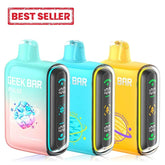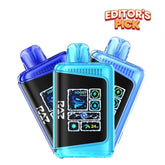How to Clean a Nectar Collector
Whether you have electronic or manual vaping devices, regular maintenance and cleaning is something that is required if you are looking to make sure that each dab vape session is the best it can be. That said, the approach that you will take to cleaning different devices will vary depending upon what type of product it is, how it is built, and what types of solutions are safe to clean it.
One product that will require you to better understand the device is the nectar collector. Are you the proud owner of your own dab straw or are you looking into getting one soon? If so, here is a comprehensive guide on how you should clean these products so that every hit you take offers you only the smoothest, cleanest vapors.
How to Clean a Silicone and Glass Nectar Collector
Like it is with most other vape products, the process of cleaning a nectar collector will depend upon what type of nectar collector you have. That said, there are many steps and products that are needed across the board. What will you need to have around in order to make sure that you are always ready to clean your nectar collector when it needs it?
What Supplies You Will Need
- Salt: Salt is a great cleaning tool as it not only helps loosen some of the grime and residue on surfaces but serves to help you scrub them off without severely damaging the surface of your chosen device. Most people will have salt on hand and, if you don’t, salt is always affordable and easy to get. That said, it is important that you do not use regular salt that you would use to salt your food. So, what are you supposed to get? Get larger, coarser salt that will have a real impact on the surface of your dab straw in order to get more residue off.
- Isopropyl Alcohol: Another common cleaning product that you can find in your bathroom is isopropyl alcohol or rubbing alcohol. When combined with salt, these two items create a powerful cleaning formula that gets most of the stuck-on messes off with ease. (Of course, if your device is not that dirty, you don’t necessarily have to use isopropyl alcohol and salt. Instead, you may be able to just use warm water and soap and achieve the same effect. It all depends upon how dirty your device is and whether or not hot water and soap will be enough to clean out the inside or if it will only have a minimal impact.)
- Pipe Cleaners: Thinking about scrubbing out your nectar collector with a brush? Think again. Most of the materials that nectar collectors are made out of can be delicate, which means that scrubbing too hard can do damage to the surface. Having pipe cleaners on hand can help you scrub lightly and reach more difficult areas throughout your nectar collector. This isn’t something that everyone has laying around, but like the rest of the products on this list, pipe cleaners are cheap and easy to get!
- Q-Tip: While pipe cleaners will give you the ability to scrub lightly, they make it hard to apply the force needed on tougher stains. Q-tips, on the other hand, still provide that light touch that won’t damage your nectar collector but give you the opportunity to scrub harder when needed. If possible, you may wish to purchase different sizes so that you can reach harder areas that may not be within the reach of regular size Q-tips.
Cleaning Your Kit
So, we’ve established what materials you are going to need to start cleaning your nectar collector. But what does the process of cleaning actually look like? Once you have everything out and set up, you will need to begin by:
Open the Entire Kit
Nectar collectors come in various sections, with the different pieces generally being the tip and the body. When you first start the cleaning process, take these pieces apart, keep the body open, and get ready to begin applying the necessary solution mixes so that you can start scrubbing and rinsing when ready.
Soak It in Isopropyl Alcohol
Once you have all of the individual pieces separated, mix the isopropyl alcohol and salt together and either put the solution into a bag or a container. Once you have the evenly-mixed solution ready for your materials, place the body of the nectar collector into the bag, making sure that the solution is able to make its way throughout the entirety of the piece. Most recommend soaking for at least 30 to 60 minutes. However, you can soak your piece for as long as you feel is needed until the residue begins to loosen and can be easily rinsed off.
(NOTE: You do NOT soak the tip with the body if you have a titanium tip. Instead, the tip needs to be cleaned by heating it as you would to take a dab and waiting for the built-up reside to begin running, using a Q-tip to clear off the material once it has cooled down enough to safely apply it to the inner surface and other areas of the tip, and use a scraper pic if you are having a very difficult time getting the residue off. If you have a ceramic tip or a quartz tip, you can safely clean these along with the body of your nectar collector.)
Clean It With a Q-Tip
Once you have let your nectar collectors soak for the allotted amount of time, take it out and rinse it a little with some warm water. If there are any areas that are not easily rinsing off, take a Q-tip and begin to scrub lightly to remove any difficult residue. It may take a couple of runs, but the residue will come off after enough soaking and scrubbing.
Soak The Nectar Collector in Warm Water
Another method that you can use to clean your product is to place it in warm water and soap. The isopropyl alcohol and salt mix is great for stuck-on residue, but if you clean your dab straw frequently, you may not need to waste these materials on your piece. Instead, follow the same directions listed above and soak your device for as long as you see fit.
Thoroughly Rinse the Entire Inside
Rinsing the product will help to loosen any stuck-on residue before you scrub. However, it is important that you do so with hot water as cooler water may not be enough to get the desired effect. Hold your product under hot running water and even use the sprayer on your sink to get all of the nooks and crannies on your dab straw. This will help you identify which areas will actually need to be scrubbed once no more residue is washing off of the inside of your straw.
Use Pipe Cleaners for Tough to Reach Spot
Is the Q-tip not doing the job for you. Don’t fret. Using a pipe cleaner can help you get the job done. Although it may be wide enough for certain areas, you may find that folding or twisting your pipe cleaner will improve its width so that it scrubs with ease. Once you have your pipe cleaner ready, carefully lower it into the body and push it back and forth, being careful so that you don’t rub the metal portion of the pipe cleaner against the body of your nectar collector.
Let it Dry
After you’ve followed the directions above, do one final rinse of your product and take a look to make sure everything has been cleared from the inside of your nectar collector. Then, lay it out so that it dry, making sure that it is standing up so that the leftover water doesn’t pool on the side. If you’ve gotten every single piece of residue, your piece will be ready to use after it dries!
FAQ
Even though cleaning your nectar collector can seem easy, there are some additional questions that most nectar collector owners ask to make sure that they get the process right each time. Here are some frequently asked questions that you may have in mind.
Why You Need to Clean a Nectar Collector
Some people may ask, why do I need to clean my nectar collector? There are actually several reasons why you should prioritize the cleanliness of your nectar collector. The first is that built-up reside can restrict airflow and make your nectar collector work harder in order to deliver vapors to you. The second reason is that having all of that residue inside your dab straw can affect the flavor of your concentrates, making it taste worse than it should. If you want your dab straw to be efficient and produce flavorful vapors, you need to make sure that it is clean.
How Often Should I Clean It?
The answer to this question will depend upon how frequently you wish to clean it. Some people clean their devices regularly, which can help prevent hard residue from having the opportunity to serious build up in the first place. However, if you are someone who has a tendency to clean less frequently, the answer is that you should be cleaning your nectar collector at least every three to six months. Why? This is done to ensure that mold and bacteria don’t grow on the inside of your device, which could pose a threat to your overall health.
Is Cleaning Glass and Silicone the Same Process?
The answer is both yes and no. If you have a silicone piece instead of a glass piece, you can most certainly soak it and clean it out once it has soaked for a certain period of time. However, there is another way that you can clean silicone. Rather than soaking it, remove the tip and place it in the freezer for around four to six hours or allow it to sit in the freezer overnight. When you take it out, it should be frozen and harder than it normally is. Take your silicone and squeeze it. This will help to crush any of the caked-on residue and separate it from the surface of your device, which may be easier than soaking and scrubbing! Unfortunately, with glass, you can only soak it to get the residue off.
(ADDITIONAL NOTE: This may be common sense, but the approach you will take with electronic devices will be different than the directions listed above. These pieces will generally have the tip, which will be cleaned as listed above but may feature a different body that will not allow for soaking. If you choose to purchase an electronic nectar collector instead of a glass or silicone product, make sure to do some research to see how your product is built, how others are making sure that it is clean, and how you can avoid doing accidental damage by cleaning it wrong. Otherwise, you may end up doing extensive damage to an expensive piece of equipment.)
Like it is with other glass pieces such as bongs, pipes, and dab rigs, you must clean out your nectar collector regularly if you want to make sure that your device is functioning optimally, that you are getting a clean vapor hit each time you dab, and that you avoid potentially dangerous mold and bacterial growth.
Don’t know where to start and want to make sure that you are doing it right when it comes time to clean your nectar collector? The guide above will help you learn more about the tools and materials you will need to properly clean your device, what steps you will need to take to get all of the built-up residue out, and how you can avoid doing any damage to your manual or electronic nectar collector along the way!














